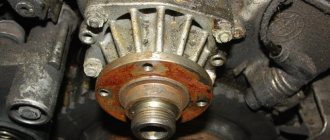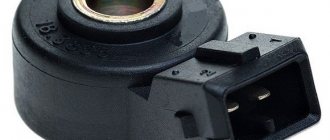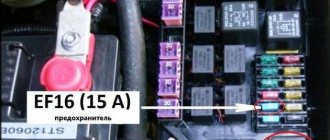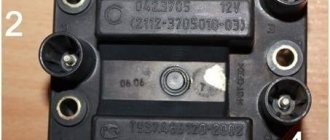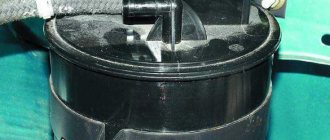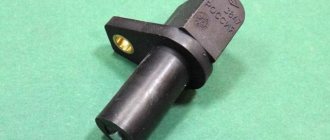Operating a car without a cooling system is practically impossible. In the cold season, the car will work for half an hour, and in the warm season – no more than 5-10 minutes. The pump is used to circulate coolant throughout the vehicle. If the water pump is faulty, fluid stops circulating, causing overheating. What are the signs of a part failure, and when to change the pump?
The temperature of the sensors does not reflect the operating temperature of the engine at all - its indicators are several times higher. They display the temperature inside the cooling system. This means that the liquid heats up to 80-90 degrees.
On a Priora, like any other car, it is impossible to operate the engine without a pump connected to it. It doesn’t matter whether there are 8 or 16 valves in the system, but what is important is that if the timing belt is not securely fixed, the engine will not start. By the way, on both types of engine the location of the water pump does not change. The timing belt itself on the Prior 16 valve version of the engine is longer.
Symptoms of malfunction
- Noise from the pump when the engine is running. Extraneous sound appears due to bearing wear. It is recommended to replace the cooling system pump after one or every replacement of the timing belt kit. If you neglect service intervals, wear appears on the rolling elements, inner and outer races, which leads to noise and whistling. Often the cause of accelerated wear is antifreeze, which, due to a leak in the oil seal or rubber cuff, gets to the rubbing vapors.
- Antifreeze leak. Like the pump bearing, the oil seal and rubber seal have a limited service life. The appearance of play due to bearing wear will significantly increase the risk of seal leakage.
- Misalignment with respect to timing gears and rollers (the pump becomes askew). Uneven tension distribution leads to accelerated wear of not only the bearing, but also the oil seal. Incorrect installation or a manufacturing defect, in which the pulley rotates misaligned, leads to accelerated wear of the loaded part of the belt. Such a defect, even with low mileage, can cause the timing belt to break and the valves to meet the pistons.
- Engine overheating. When the impeller blades break off, the pump's performance decreases, as a result of which less coolant passes through the small circulation circuit.
Often a decrease in performance is noticed after using a sealant to repair a radiator leak. The poured mixture clogs the cooling system channels and sticks to the pump impeller.
If the liquid has not clogged the coolant drain channel in the housing, then pouring sealant will not lead to a malfunction of the water pump. But you can’t do without removing the pump and flushing the system.
A little about the difficulties of repair
The cooling system performs an important function. Replacing its components, and especially the pump, must be approached responsibly, carefully weighing your strengths. To carry out the work you will need:
- understanding of the operating principles of the node;
- a set of keys, including for the tension roller;
- assistant;
- availability of 6-8 hours of free time.
The main difficulty of replacement is the inaccessibility of the attachment points. Carrying out the work requires the ability to adjust the valve timing.
Why do you need an assistant? Some operations, such as tensioning the timing belt, cannot be carried out alone.
If the procedure for replacing the water pump causes difficulties or concerns, then you can contact a service station. The cost of the work is quite low, as is the pump itself. Therefore, you should not put off replacing it - this can result in expensive repairs.
Source
How to check the cooling system pump?
By checking the pump without removing it from the engine, we can only indirectly assess its performance. When the volume of pumped coolant decreases, the stove begins to heat poorly. But before removing the water pump to inspect the impeller, we recommend checking the thermostat and also making sure that there is no air lock in the cooling system.
After removal, pay attention not only to the integrity of the blades and where the impeller fits on the drive shaft, but also to the shape of the blades. For example, on the VAZ 2121 over many years of production, impellers were installed that differed in the diameter of the pump wheel, the number and profile of the blades. Installing a less efficient pump on a more heat-loaded engine modification will result in the cooling system fan turning on more frequently and an increased risk of overheating.
Be sure to inspect the engine block where the housing fits and the pump itself. Fogging or a slight leak of coolant from the drain hole does not mean that the pump should be replaced. If a significant leak is detected, try to pinpoint the location of the leak. If the leak is only at the junction of the housing and the engine block, most likely the problem can be eliminated without replacing the pump. It will be enough to apply sealant and install a new gasket.
Risk of timing belt breakage
The danger with a misaligned water pump timing belt is that there are no obvious signs of failure. First of all, you need to pay attention to the timing belt. If it is pulled to any side, uneven production is observed, it is necessary to check the pump and rollers. The cause of the misalignment may be a manufacturing defect, bearing wear, or uneven fit of the housing to the engine block (dirty, rusty mating planes). Sometimes the malfunction begins to manifest itself after an accident, when elements of the body or attachments hit the pump pulley.
If a misalignment is detected, the defective pump must be replaced as quickly as possible. Also, do not hesitate to eliminate noise and whistling from the water pump. If wear is critical, the bearing may collapse, thereby blocking the toothed pulley. A jammed pump is guaranteed to lead to a broken timing belt. If on your car the pistons meet the valves when they break, then eliminating the consequences of the malfunction will cost a fairly large sum.
The best pump for a prioromotor
If you live in a priorovode, what’s the point of asking here? The people there are much more competent in these matters.
Hepu has good pumps, but there weren’t any for the priorozub. Maybe things have changed now. Someone stupidly ignored the difference in the profile of the teeth and installed them.
IMHO TZA with authentication. And keep an eye on it from time to time. I also have 50 thousand now, everything is original in the timing belt.
Did it rotate smoothly in the store or didn’t you check it?
But I will take an alternative. I have no luck in the lottery
If you live in a priorovode, what’s the point of asking here? The people there are much more competent in these matters.
Hepu has good pumps, but there weren’t any for the priorozub. Maybe things have changed now. Someone stupidly ignored the difference in the profile of the teeth and installed them.
IMHO TZA with authentication.
And keep an eye on it from time to time. I also have 50 thousand now, everything is original in the timing belt.
There are no more checks. And so I appreciate the original technical specification. I took this one for myself.
Main reasons
Before talking about the signs of a dying pump that needs replacement or repair, you need to say a few words regarding the reasons for the failure of this device.
In total, there are several main factors that cause this to happen:
- Using low quality antifreeze. About 90% of pumps break down precisely because of this. Such a cooling liquid contributes to the appearance of tarry deposits, which makes the impeller difficult to rotate;
- Corrosion. Again due to low-grade antifreeze;
- Cavitation, that is, the formation of vacuum bubbles that can literally tear out pump particles and destroy the mechanism;
- The result of normal wear and tear. Each device has a limited resource. The best samples last about 200 thousand kilometers;
- Broken fastening. It's simple. The fasteners became loose, the pump became loose and fell apart.
In most cases, it is the car owner himself who is to blame. Drivers are required to monitor the condition of the cooling system, periodically check the pump, and change the coolant on time.
We cannot exclude the problem of manufacturing defects, as well as simply low-quality and cheap pumps that are installed on budget cars or as part of repairs, thereby deceiving the client.
It is not surprising that the timing belt may then fail, the tension roller may rupture, the cylinder head gasket may break through, and other troubles that can cost a lot of money during repairs.
Problems with the water pump can occur on various cars:
- on Kalina;
- VAZ 2110;
- Lada Priora 16 valves;
- VAZ 2114;
- Lada Priora 8 valves;
- VAZ 2115;
- Daewoo Lanos;
- Niva Chevrolet;
- Daewoo Nexia;
- Lada Granta;
- Renault Logan;
- Chevrolet Aveo, etc.
Don’t think that this is a problem exclusively with cheap and budget cars, as well as simple engines like ZMZ 406.
The pump can also be used on more expensive cars. It all depends on how the owner monitors and maintains the car with his own hands, or in a car service center.
About the resource
Well, now we’ve come to the most interesting thing, namely the resource. You know, now I want to talk specifically about normal belts and tensioning equipment, about “PRIORS” will be a little lower.
Not all manufacturers strictly indicate how often to change the belt, but such information can still be found, even in the car’s operating books.
The average mileage recommended for replacement is 100,000 kilometers. On many foreign cars, this mileage can be much longer, about 150,000 kilometers.
Now the question may arise: what does it depend on? Guys, to be honest, the belt itself can run (as some manufacturers claim) about 200,000 km, but its service life is reduced due to tension and support rollers. They are often the culprits of the cliff!
The support roller is a kind of bearing on which the belt rests, often has a plastic housing.
The tension roller is almost the same plastic bearing, only it is located on a special mount that “tensions” the belt, that is, it keeps it in “tone” and prevents it from “sagging” and jumping onto a tooth.
Both videos must be of simply excellent quality, no, they simply must ! With foreign cars this is almost always the case, these “support” and “tensioner” last a long time, and replacement is 100 - 150,000 km in advance.
If one of the rollers stands up, the belt wears out, within some 100–200 km of travel, or maybe even less.
As you may have guessed, not only the belt is changed, but also the tension and support rollers - THIS IS MANDATORY, REMEMBER THIS! As an indirect reason for a future replacement, there may be noise from the timing drive; when the rollers begin to “bend”, they begin to make noise.
Signs of trouble
I would like to immediately note that in order to determine faults in the water pump, you will need to remove the unit and disassemble it. Only this method provides a real opportunity to see the resulting traces of corrosion, signs of cavitation and contamination.
Practice clearly shows that this happens on a wide variety of machines:
- VAZ 2107;
- Volkswagen Passat;
- FF2, that is, Ford Focus 2nd generation;
- Lada Granta;
- Kia Spectra;
- Chevrolet Aveo;
- Audi A5;
- Nissan Qashqai;
- Mitsubishi Outlander;
- Toyota Camry;
- Skoda Octavia, etc.
Replacement cost
Not everyone takes on a water pump with their own hands if it must be replaced. They prefer to go to service centers or just some garage-type workshops, where prices are usually lower.
It is important to note that the cost of replacement directly depends on the car make, model and availability of the spare part itself. In some cases, replacement is carried out in literally 20 minutes. In other situations, craftsmen spend several hours. Moreover, most of the time is spent on getting to the pump and removing it.
All this has led to the fact that price tags vary greatly, depending on certain conditions and circumstances. In one case, you will pay about 1000 rubles. In another you will have to pay 5-6 thousand. And this does not take into account the cost of the newest pump for your car.
The purpose and general design of the pump in the Lada Priora car
An auto water pump (VP) or pump is structurally included in the liquid cooling system (LCS) of a modern car and is its key element. The main function of this part is to ensure intensive circulation of coolant (coolant) through the engine's fluid circulation system.
Thanks to this constant movement, the temperature of the liquid decreases and its ability to cool other parts and systems of the car is restored. As a rule, the water pump on a car engine is structurally located in front of the cylinder block. Its drive is carried out from the crankshaft through a special wedge-shaped belt or from the gas distribution mechanism (timing) using a toothed belt.
A special toothed belt ensures the functioning of the car's water pump.
General pump structure
The Lada-Priora pump is a fairly simple mechanical unit, which consists of several main parts.
The pump design consists of several elements, one of which is the obligatory gasket
The main components of an engine water pump are:
- product body;
- a shaft with an impeller and a special self-regulating oil seal, thanks to which the coolant is securely retained in the structure during operation;
- pump shaft bearing on which the pump shaft is mounted;
- drive pulley;
- radiator fan (this part can be attached to the pump drive or in a separate electric drive version, without any connection with the car’s water pump);
- gasket made of cardboard or special material.
Operating principle of the device
The operation of the coolant pump is as follows:
- with the engine running, the coolant that has cooled in the car radiator moves to the pump (in particular, to its impeller);
- the gaps between its blades are completely filled with coolant;
- due to the action of centrifugal force, the coolant is thrown by the impeller into different directions of the internal cavity of the HV;
- through the technological hole, the liquid goes into the channels of the cooling jacket of the motor elements;
- constant circulation of the cooling medium in the liquid cooling system is ensured.
Design Features
To prevent possible leakage, the pump body is installed on the engine cylinder block through a special gasket (for example, made of cardboard). The cooling fan, which is sometimes structurally located on the car pump pulley and driven simultaneously with it, is usually made of metal or durable plastic. To reduce operating noise, the blades of the structure are located at certain angles, in an X-shaped position, which corresponds to 110/70 degrees.
In order to reduce the power required to drive the fan, designers use a special electromagnetic clutch. This device can turn off the fan when the coolant temperature drops to a level of 78–85 degrees Celsius. In this way, the operation of the engine cooling system is optimized, and the noise level during operation of the unit is also reduced.
Should I change antifreeze after replacing the pump?
A question for those who want to save money everywhere and on everything. If I answer this briefly, I can confidently say that yes, the coolant needs to be changed. Please also pay attention to the question regarding mixing antifreeze in the cooling system. It will be useful and important to know all the nuances.
If we talk about the necessity of replacement, then everything is extremely simple. To begin with, in the vast majority of cases it is impossible to replace and remove the pump without first draining the antifreeze from the system. But some people want to save money; they drain the coolant into a clean container, install a new pump, and then pour the old antifreeze back in.
A big mistake, since any water pumps for cooling systems are characterized by increased demands on the quality and purity of the liquid. Therefore, you should absolutely not use previously drained antifreeze, even if you just recently changed it, even before the pump failed. Do not attempt to filter or strain the coolant. Just buy a new can of quality antifreeze that is suitable for your car and fill it up. There simply cannot be any other options. Remember this. Otherwise, you will soon have to spend money on a new pump again.
To ensure that the water pump lasts as long and reliably as possible, make it a rule to use only high-quality compounds. As you remember, 90% of pump failures are related precisely to the quality of the coolant used. I think it will not be difficult to draw the appropriate conclusions.
Have you encountered a water pump failure and how early were you able to identify the presence of malfunctions?
Thanks to everyone who reads us! Don't forget to leave comments, ask questions and invite your friends to join us!
(
1 ratings, average: 5.00 out of 5)
Did you like the article?
Subscribe to updates and receive articles by email!
We guarantee: no spam, only new articles once a week!
Step-by-step instructions for replacing the pump on a Lada-Priora car yourself
It should be noted that it is impossible to replace the water pump on a Lada-Priora car without dismantling the engine generator drive.
Required Tools
When replacing the water pump on a Lada Priora car, you will need the following tools:
- open-end wrenches No. o10, No. o15, No. o17;
- spanners No. o15, No. o17;
- Allen key No. o5;
- two screwdrivers of different sizes;
- a specially designed wrench for installing the tension roller or a puller for retaining rings;
- Torx T-30 wrench used to remove the five screws that secure the front upper timing cover;
- mounting blade.
Photo gallery: a set of tools for replacing the water pump on a Priora
The procedure consists of performing the following operations:
- The wire is disconnected from the negative terminal of the battery.
- The used coolant is drained from the vehicle's liquid coolant.
- For convenient operation, you can dismantle the adsorber (not necessarily disconnecting all its communication connections).
- At the next stage, the protective plastic engine cover is removed, as well as the belt protection cover, which drives the gas distribution mechanism (abbreviation - timing).
- Using a jack, the right front part of the car is raised, and the front right wheel is hung in the direction of travel.
- It must be removed to provide access to the timing belt housing mounting bolts.
- The position of the timing mechanism is determined by the marks (additionally, for convenient subsequent work, you can make your own marks using white paint).
- The rollers, drive pulleys of both camshafts, and the timing belt protective cover are also removed, for which it is necessary to slightly loosen the tension roller clamp.
- The timing belt is removed.
- The gears of both camshafts are unscrewed after first locking them with some flat tool (this must be done carefully so as not to damage their teeth).
- To dismantle the car's water pump, unscrew the mounting bolts, which are made for a hex key with size No. o5.
- It is necessary to unscrew them and, by tapping on the pump body, and also using a screwdriver inserted into the groove, try to pull out the water pump.
- It is possible that residual coolant will be drained, so some kind of container is provided to collect it (you need to be careful when performing this step).
- If the pump gasket remains glued to the engine body, it must be removed (this part is replaced with a new one during subsequent installation).
Assembly is carried out in reverse order.
Installation of the water pump is as follows:
- The tightening of the screw that locks the bearing installed in the VN housing is checked.
- The screw is tightened if necessary.
- The new pump is installed so that the product number is at the top.
- The mounting bolts are tightened.
- A plastic casing is installed.
- Both camshaft pulleys are secured, as well as the timing rollers.
- The engine timing belt is put on according to the pre-marked marks.
- The wheel turns the engine crankshaft.
- The tension specified by the manufacturer is adjusted, as well as the position of the belt in the pulley grooves and on the rollers.
- Top up the used coolant.
- All removed wires and hoses are connected.
- The generator drive is connected.
- The engine starts to perform the test.
Basic faults
The main reason for pump failure is bearing malfunction. The following malfunctions of this part can be identified:
- The bearing is jammed. If a whistle or hum appears on the right side of the engine when the engine is running, it is time to replace the pump. If there is a lack of lubrication in the bearing, it stops spinning, which leads to a break in the timing belt.
- Formation of play on the bearing. If, when inspecting the car, you find traces of coolant on the pump body, this is the first sign that the pump has exhausted its service life.
- If there is a smell of coolant in the cabin, a hum when the car is running, or signs of antifreeze leakage, the pump should be replaced.
Checking the serviceability of the water pump without dismantling it
To determine whether the water pump is working properly on a Lada-Priora without removing it from the car’s engine, it is necessary to take the following steps:
- start and warm up the power unit to its operating temperature;
- squeeze the upper hose from the radiator with your hand;
- By tactile sensations you can understand that coolant circulates through the cooling system, which means the water pump is working properly.
The presence of extraneous hum or noise in the pump area indicates an imminent possible failure of the device bearing. In this case, it is recommended to replace the auto pump with a new one.
During normal operation of the pump, coolant circulates intensively through this pipe.
Why is replacement needed?
The pump is an important part of the car; if it breaks down, the car engine will stop cooling, which will lead to serious malfunctions:
- Engine overheating. Failures in the cooling system lead to engine overheating.
- Broken timing belt. A jammed bearing or play formed on it leads to damage to the timing belt.
- Valve failure. A broken timing belt bends the valves, the engine fails and requires serious repairs.
You can continue to operate the vehicle if there is a slight coolant leak and if a hum has recently appeared. But you should understand that a small leak will develop into a large one, and the bearing will soon jam, and the cheaper the pump, the sooner this will happen. It is better not to let the engine overheat and promptly replace the pump on the Prior.
Timing belt
How would you act on your own without clear instructions in the service book? On both an 8-valve and a 16-valve engine, I would change at least the pump, and better yet, the belt and tensioner between the 60th and 70th thousand kilometers. According to the period, if the mileage is small, for the sixth year of operation.
hi guys))) please tell me when to change the pump on a Priorika 16 cl? I changed the belt, and now I regret that I didn’t replace the pump... what is its service life? When replacing the belt, I twisted it without jerking, there is a small play but it doesn’t leak ) mileage 61000
Now that I'm tired of washing the gray insert
by Adminrive · Published 10/07/2014
In general, who is from Moscow
by Adminrive · Published 07/30/2015
Replacement
You can replace the pump yourself; for this you will need: a 10mm socket, wire cutters, a screwdriver, a 6-corner bit, and a small ratchet.
- We drive the car onto the overpass, unscrew the crankcase and engine protection, thereby freeing access to the engine. Open the hood and unscrew the cap on the left side of the radiator and drain the antifreeze. If you plan to refill the same liquid, then place a bucket under the radiator.
- We look for a bolt on the front part of the cylinder block and unscrew it. We also drain the antifreeze from the engine into a bucket.
- We remove the plastic decorative trim on the engine; to do this, you just need to pull it up.
- We connect the ratchet with the bit and unscrew the bolts holding the front timing belt cover.
- We align the upper pulleys according to the marks on the rear timing belt cover.
- We unscrew the two timing belt tensioner rollers.
- Remove the belt and gear.
- We unscrew the two upper toothed pulleys and then pull them out.
- Using a 10mm socket, unscrew the 6 bolts on the rear cover of the timing gear drive and pull it out.
- Armed with a ratchet, unscrew the 3 screws securing the pump.
- Using a screwdriver, use a screwdriver to pry up the pump and remove it.
- We clean the pump seat from dirt and remnants of the old gasket with a dry cloth.
- On the new pump, lubricate the gasket seat with a small amount of sealant.
- We put on the gasket and also lubricate it.
- We install the pump on the engine so that the hole in its body looks down into the nearest hole to the filter.
- We tighten the bolts holding the pump.
- The pump has been replaced. We assemble all the parts in reverse order. Don't forget to add coolant.
At the slightest sign of pump malfunction, it is recommended to inspect and replace it. Otherwise, the car's cooling system will be disrupted and engine overheating will be inevitable. And its repair will require more serious financial investments.
see also
Audi spare parts - which ones are best to buy?
- 0 0 1k
Original Renault spare parts. How to distinguish from a fake
- 18 0 9k
Which timing belt is better?
- 503 27 217k
Timing belt
- 0 0 74k
Replacing the timing belt
- 45 6 83k
Many owners of front-wheel drive VAZs are concerned about the problem of why the timing belt is eating ? Most often this question is asked by owners of the following VAZ models - 2108, 2109, 2110, 2112, 2114, Kalina, Priora, Grant (and this problem occurs on engines with both 8 and 16 valves). There is only one general answer to the question raised: the belt is skewed. And this, in turn, can happen for a number of reasons - the pump is installed unevenly, the roller is of poor quality, a washer of the wrong size is installed between the roller and the block (or it is missing altogether) and some others. Each of the listed problems is solved in its own way. In most cases, work to eliminate the causes can be carried out independently, provided you have the appropriate experience and tools. This will save money, and the repair work itself does not take much time and effort.
